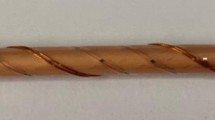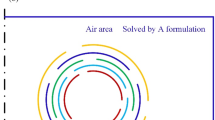Abstract
The CICC (cable-in-conduit conductor) in ITER (International Thermal-nuclear Experimental Reactor) will run in high-current, fast transient magnet field and complex environment. In response to the impact of magnet fields above 10 T, the Nb3Sn conductor has been introduced. However, the AC (alternating current) loss mechanism of Nb3Sn conductor on strain has not been explored. So, it is necessary to study the AC loss calculation method with transient electromagnetic field and wide range of strain, the coupling current in complex field and current signal of field is simplified to the spectrum effects of coil excitation, and calculation technology of AC loss, which contains the frequency, magnet field, coil characteristics and other parameters, is constructed to meet the discrete Fourier transform (DFT). By comparative analysis of simulation, it is found that the AC loss calculation of the conductor with spectrum algorithm is closer to the actual project value than the traditional algorithm. For the rapid excitation, in particular plasma discharge and burst, spectrum algorithm and the traditional algorithm are consistent. For the relative error calculation of hysteresis loss and coupling loss, it is found that the coupling loss is cumulative linearly, where the hysteresis loss is not so. As a function of the amplitude, frequency and phase angle, the relative error is less than 40%. The results showed that the method of Fourier restructuring is satisfactory.
Similar content being viewed by others
References
Dresener L. Twenty years of cable-in-conduit conductors: 1975–1995. J Fus Energ, 1995, 14: 3–12
Seeber B. Hand Book of Applied Superconductivity. London: Institute of Physics Publication, 1998. 265–280
Yan L G. Recent progress of superconducting magnet technology in China. IEEE Trans Appl Supercond, 2010, 20: 123–134
Ciazynski D. Review of Nb3Sn conductors for ITER. Fus Eng Des, 2007, 82: 488–497
Liu B, Wu Y, Liu F, et al. Axial strain characterization of the Nb3Sn strand used for China’s TF conductor. Fus Eng Des, 2011, 86: 1–4
Liu F, Weng P D, Wu Y, et al. Study on the performance test of superconducting strand Nb3Sn (in Chinese). Chin J Low Temp Phys, 2007, 29: 68–72
Zhang P X, Liang M, Tang X D, et al. Strain influence on Jc behavior of Nb3Sn multifilamentary strands fabricated by internal tin process for ITER. Physica C, 2008, 46: 1843–1846
Liang M, Zhang P X, Tang X D. Strain effect on transport properties of Nb3Sn multifilament strands prepared by internal tin route (in Chinese). Acta Metallurg Sin, 2009, 45: 223–226
Cheng J S, Wang Q L, Dai Y M. Characterization and analysis of microstructures of Nb3Sn multifilamentary superconductors during diffusion treatment by bronze route (in Chinese). Rare Metal Mat Eng, 2008, 37: 189–192
Bruzzone P. AC losses and stability on large cable-in-conduit superconductors. Physica C, 1998, 310: 240–246
Fang J, Weng P D, Chen Z M, et al. The ac losses measurement and analysis of superconducting NbTi CICC for HT-7U superconducting Tokamak. Plasm Sci Technol, 2003, 14: 76–82
Wang Q L. High Magnetic Field Superconducting Magnet Science (in Chinese). Beijing: Science Press, 2008. 248–299
Bottura L, Bruzzone P, Lister J B, et al. Computation of ac losses in the ITER magnets during fast field transients. IEEE Trans Appl Supercond, 2007, 17: 2438–2441
Egorov S. AC coupling losses in superconducting multistage cables with and without additional co-twisted copper strands. Physica C, 1998, 310: 272–276
Jiang H W, Wu S T. Research of simulation design for CICC based on energy margin and temperature margin. IEEE Trans Appl Supercond, 2010, 20: 1436–1439
Jiang H W, Wu S T, Cheng J S. Optimization model of a structural simulation design for a CICC. Chinese Sci Bull, 2011, 56: 2978–2983
Li B Z, Bi Y F, Wu W Y. Calculation of ac Losses in large scale superconducting cable (in Chinese). Cryogenics & Superconductivity, 2000, 28: 14–18
Fang J. The theoretical and experimental research on HT-7U CICC stability (in Chinese). Doctoral Dissertation. Hefei: Institute of Plasma Physics, CAS, 2002. 58–69
Marinucci C, Bottura L, Calvi. A parametric ac loss model of the ITER coils for control optimization. Cryogenics, 2010, 50: 187–199
Jiang H W, Wu S T. Research of simulation design model for CICC based on strain (in Chinese). Acta Electronica Sinica, 2010, 38: 1334–1338
Wang Y S, Guan X J, Zhang H Y, et al. Progress in inhomogeneity of critical current and index n value measurements on HTS tapes using contact-free method. Sci China Tech Sci, 2010, 53: 2239–2246
Author information
Authors and Affiliations
Corresponding author
Rights and permissions
About this article
Cite this article
Jiang, H., Wu, S., Zhang, D. et al. Calculation model of AC loss for CICC (cable-in-conduit conductor) based on strain. Sci. China Technol. Sci. 55, 1132–1139 (2012). https://doi.org/10.1007/s11431-011-4721-5
Received:
Accepted:
Published:
Issue Date:
DOI: https://doi.org/10.1007/s11431-011-4721-5




